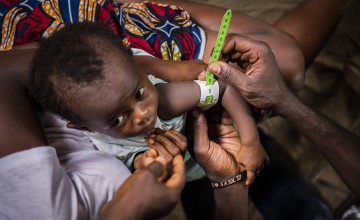
Read our 2023 annual report

Knowledge Hub
Malnutrition now 'a major global public health threat'

Humanitarian and development leaders have warned that malnutrition is now a "major global public health threat", with at least 50 million children worldwide suffering from an acute form of the condition.
On World Food Day, those working in the humanitarian sector have joined together to highlight the fact that nearly 50% of all deaths of children under five are driven by malnutrition.
Acute malnutrition has been – and remains – highly treatable and preventable. Yet, despite the existence of life-saving treatment and two decades of work to reach those in need, current strategies reach less than 20% of affected children with care.
Today, we are at a critical crossroads. We can choose to stay the course, leaving an estimated 80% of acutely malnourished children untreated. Or we can transform the system and save millions of lives.
What's holding us back?
The problem is four-fold:
- The current approach to treating acute malnutrition is fragmented and unnecessarily complicated with moderate and severe acute malnutrition treated separately in systems overseen by two different UN agencies.
- Diagnosis and treatment for acute malnutrition is complicated and confined to health facilities meaning the burden is on the parents and their children to travel long distances to access life-saving care.
- Funding for acute malnutrition treatment does not match the scale of the crisis.
- There is a lack of national ownership with ministries’ of health and finance often failing to adequately prioritize nutrition-related policies and budget lines.
We see these challenges every day in the countries and communities where we work. Political will and financial investment is urgently needed to address each of these barriers.
We, a group of leading humanitarian and development organizations working in some of the hardest to reach places, are calling on world leaders – from UN officials to Ministries of Health – to accelerate action toward a more effective, efficient and accessible treatment system that leaves no child behind.
The time is ripe for action and accountability
This past July, leaders from across the United Nations system announced they would develop a Global Action Plan on Wasting by the end of 2019 with a roadmap to address acute malnutrition.
With less than two months until the UN shares the most comprehensive plan on wasting in recent history, here are our recommendations for what the Global Action Plan (GAP) must include:
- A commitment to simplifying the current treatment approach so that all children with acute malnutrition – regardless of the severity – are treated in a single program.*
- A time-bound blueprint for how the United Nations will change to a single treatment system, adopted by all UN agencies, with unified leadership in place to ensure strong oversight and accountability for the global system.
- A clearly articulated vision and implementation plan for how the UN leadership will drive this systems-level change across UN entities at global and national levels.
- A commitment to update the WHO treatment guidelines by mid-2021 through coordinated efforts to generate the operational evidence needed and to provide interim guidance where context- specific evidence already exists.
- A commitment to promoting more continuum of care approaches linking treatment to prevention.
- A roadmap for how the World Health Assembly (WHA) and Sustainable Development Goal (SDG) targets on wasting will be achieved with an emphasis on building national ownership.
- A commitment to resource mobilization to secure the financing required to achieve the WHA wasting target by 2025 and SDG wasting targets by 2030, with Nutrition for Growth 2020 serving as a critical opportunity for donor and member state commitments.
- A commitment to, and plan for, civil society engagement, in the GAP development and implementation.
Standing together
And because we all have a responsibility, we stand ready to work together to ensure the Global Action Plan is ambitious, time-bound, and offers concrete steps for addressing the realities of the crisis; to hold leadership accountable to the commitments made; to continue strengthening our programs, strategies, and partnerships that put a premium on expanding access to both curative and preventative services; and to advocate with Ministries of Health and Finance to see these solutions adopted into national health and nutrition action plans and budgets.
Now is the time to turn goodwill into action and to give this neglected health issue the attention and resources it deserves and requires. Some global crises seem insurmountable. But this isn’t one of them. As we stand at this crossroads, we know we cannot stay the course. We must seize the opportunity presented by the GAP to positively disrupt the status quo.
Now is the time to act.
Find our more about global hunger with our Global Hunger Index 2019
Our impact in 2023
people reached through our emergency response
people reached through our health interventions
people reached through our livelihoods programmes





